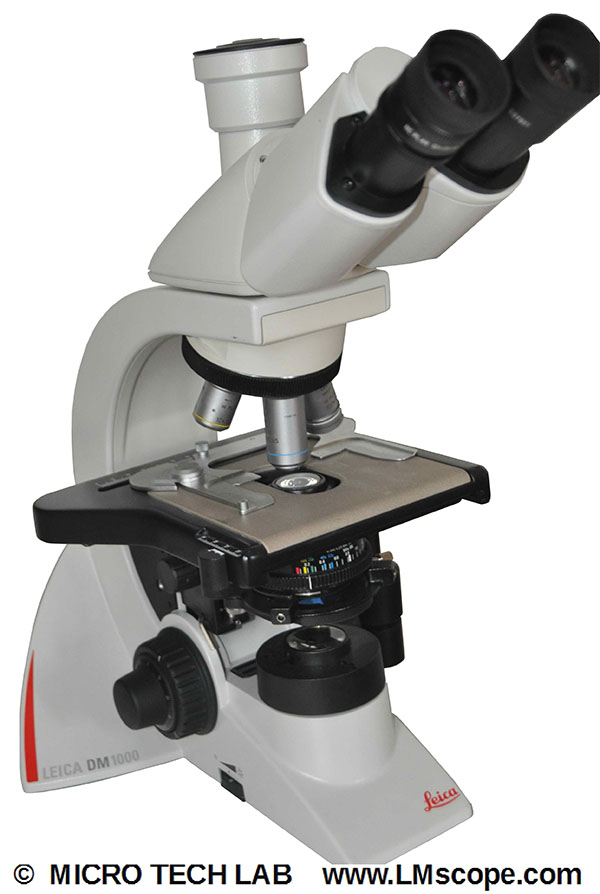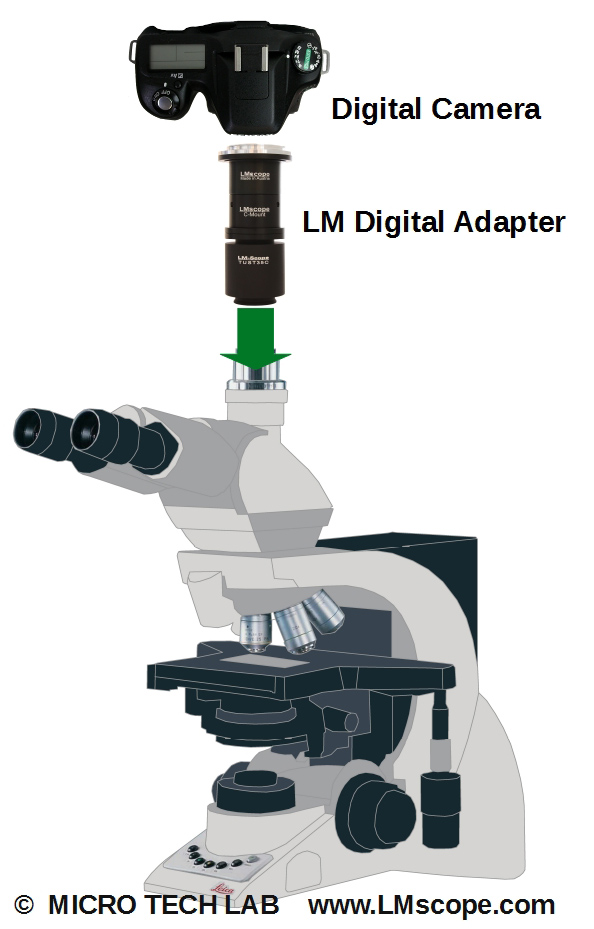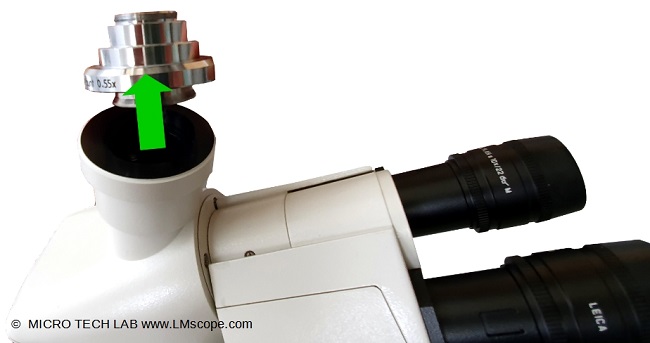

The Leica DM1000 – DM3000 research microscopes and their practical use in photomicrography
Leica’s DM1000 – DM3000 microscopes series includes the DM1000, DM2000, DM2500 and DM3000 models. Our LM microscope adapters allow state-of-the-art DSLR and system cameras to be attached to all models of this series, thus delivering outstanding resolution, dynamic range and light sensitivity.
Although the microscopes in the DM1000 – DM3000 series differ somewhat, depending on the tasks for which they are intended, they all adjust perfectly to the user’s specific needs and share carefully thought-out design features such as right-left handed operation, a variety of ergo tubes and ergo modules, and different illumination options. Each model features Leica’s excellent optics (including the brightness synchronised objective series HI Plan SL 4x, 10x, 40x and HI Plan 10x CY), but the range of features is adapted to different application areas. With the exception of the DM2500, all models are also available with LED illumination, which provides constant colour temperature at all light intensity levels without heating up the specimen. The specimen stages have a ceramic surface, and the adjustable torque facilitates fine positioning. A rotary specimen stage for two slides is also available. In addition, the DM2000 and DM3000 models are equipped with a sophisticated focus mechanism, featuring 2-gear or optional 3-gear focusing, with torque adjustment and adjustable stage height stop.

The DM1000 is the “smallest member” of Leica’s DM1000 – DM3000 family of microscopes
Of course, the following trinocular phototubes are also available for these high-quality instruments:
- Trinocular ergo tilting photo tube 50/50 FOV 22
- Trinocular ergo tilting photo tube 100/100 FOV 25
- Trinocular ergo tilting photo tube 50/50 FOV 25
- BDT25 0/50/100 dual port option FOV 25
- EDT22 50/50 FOV 22
Our LM digital adapters enable these microscopes to be attached to all types of DSLR cameras, mirrorless system cameras and C-mount cameras in no time at all. They are equipped with a high quality, plan-achromatic precision optical system which enables the production of photographs with excellent image quality (high resolution, focus and colour contrast) that yield a flat field of view without loss of focus at the edges.

The simplest way to attach a camera to the Leica DM3000 is via the phototube.
The microscope's phototube is repeatedly equipped with a C-mount port with reduction optics (0.55x). This mostly silver ring must be removed before the adapter solution is installed.

Leica DM1000 and DM1000 LED
A comprehensive description of this microscope can be found here.
Leica DM2000 and DM2000 LED
The Leica DM2000 supports all common contrasting techniques: bright field, dark field, phase contrast, polarisation contrast, fluorescence and DIC. It is equipped with a 30 W halogen (or LED) lamp that can be replaced easily via the lamp socket. A fluorescence axis featuring five filter cube positions on an easy-to-turn disk is also available. The objective turret with top-quality Leica optics offers a choice of six or seven objective positions.
Leica DM2500
The unique features of the DM2500 are its 12 V/100 W halogen lamp with lamp house and a built-in filter magazine for 3 filters. This model is particularly well-suited for areas of pathology and biomedical research that require specialised contrast methods such as differential interference contrast (DIC).
Leica DM3000 and DM3000 LED
The DM3000 and DM3000 LED microscopes are designed for routine and research applications in clinical laboratories and biomedical fields. In addition to the features described above, this model has a motorised objective turret, automated condenser and automatic light intensity adjustment to the light requirements of individual objectives. The 6-position objective turret of the DM3000 features Leica’s unique patented toggle mode, which allows the user to quickly switch between any two of the six objectives.
Photography:
Fitting the microscope to digital single-lens reflex (DSLR), mirrorless interchangeable-lens cameras (MILC ), digital single-lens mirrorless (DSLM) or C-mount cameras is easy with our LM digital SLR adapters, which feature a plan achromatic optical system. Our products make it possible to capture top-quality microscope images. To help you select the adapter that is right for your camera, we have set up an online configurator on our website. You can also email us – ideally with attached photographs of your microscope.
Modern DSLR and single-lens mirrorless (DSLM) offer the latest technology and are generally very well suited for microscopy applications. Most of them can be controlled remotely via PC/Mac. Because of their high sales volumes, they offer an excellent price/performance ratio compared to special-purpose microscope cameras.
Features of top DSLR and single-lens mirrorless cameras (DSLM):
- Large, powerful full-frame sensors (36 x 24 mm)
- Sensor resolution of 61 megapixels or 240 megapixels with Pixel Shift technology
- High light sensitivity (ISO 400,000+)
- Extensive dynamic range (up to 15 aperture stops/f-stops)
- Short exposure times (1/8000 second) up to 1/32,000 seconds using the digital shutter
- 4K Ultra HD or 8K Ultra HD video function
- Live video capture on external monitors in ultra HD quality
In most cases, these cameras are significantly more powerful than microscope cameras with smaller sensors (1/2" or 2/3"). On our website you will find our current camera recommendations and a camera ranking which is specifically tailored to microscopy applications.
New LM Digital Adapter for: Sony Alpha 9 III / Nikon Z9 / Nikon Z8 / Sony Alpha 7R V / Sony Alpha 1 II / Sony Alpha 1 / Sony Alpha 9 II (ILCE-9M2) / Sony FX3 Cinema Line / Sony Alpha 9 / Nikon D6 / Canon EOS R3 / Canon EOS R6 Mark II / Canon EOS R8 / Sony Alpha 7R IV / Canon EOS R5 II / Nikon Z6III / Canon EOS R5 / Sony Alpha 7S II / Sony Alpha 7S III / Sony Alpha 7R III / Canon EOS R6 / Nikon Z6 / Nikon Z6II / Sony Alpha 7R II / Nikon Z7 / Nikon Z7II / Canon EOS R / Canon EOS Ra (Astro) / Nikon Z5 / Sony Alpha 7C / Canon EOS RP / Sony Alpha 7S / Canon EOS R7 / Leica SL2-S / Canon EOS R10 / Nikon Z50 II / Canon EOS 1D X Mark III / Nikon Z50 / Nikon Z30 / Nikon Z fc / Nikon D850 / Canon EOS 1D X Mark II / Nikon D780 / Olympus OM-1 / Sony Alpha 7III / Olympus OM-D E-M1 Mark III / Canon EOS R100 / Sony Alpha 6700 / Nikon D5 / Sony Alpha 6600 / Fujifilm X-H2S /